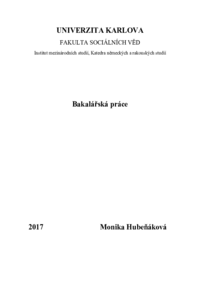Obraz nové věcnosti (Neue Sachlichkeit) v dětských románech Ericha Kästnera v porovnání s českým dobovým dílem Jaroslava Foglara, Záhadou hlavolamu
The picture of the New objectivity in children's novels from Erich Kästner in comparison with the Czech period book from Jaroslav Foglar, Záhada hlavolamu
bakalářská práce (OBHÁJENO)

Zobrazit/
Trvalý odkaz
http://hdl.handle.net/20.500.11956/90259Identifikátory
SIS: 177198
Kolekce
- Kvalifikační práce [17632]
Autor
Vedoucí práce
Oponent práce
Emler, David
Fakulta / součást
Fakulta sociálních věd
Obor
Česko-německá studia/Deutsch-Tschechische Studien
Katedra / ústav / klinika
Katedra německých a rakouských studií
Datum obhajoby
5. 9. 2017
Nakladatel
Univerzita Karlova, Fakulta sociálních vědJazyk
Čeština
Známka
Velmi dobře
Klíčová slova (česky)
nová věcnost, literatura pro děti, Erich Kästner, Jaroslav Foglar, Výmarská republika, První republikaKlíčová slova (anglicky)
New Objectivity, literature for children, Erich Kästner, Jaroslav Foglar, Weimar Republic, First Czechoslovak Republic- Obraz nové věcnosti (Neue Sachlichkeit) v dětských románech Ericha Kästnera v porovnání s českým dobovým dílem Jaroslava Foglara, Záhadou hlavolamu Cílem práce je odpovědět na to, zda lze při srovnání vybraných děl české a německé literatury pro děti najít společné či rozdílné znaky. Výzkumná otázka, kterou si v této práci kladu, zní: Jaké společné a rozdílné znaky lze najít při porovnání německé a české literatury pro děti doby nové věcnosti? Základními metodami používanými v práci jsou metody analytická a komparativní. Nejprve jednotlivé knihy analyzuji z hlediska již v úvodu stanovených kritérií. V bakalářské práci nejprve popisuji hnutí nové věcnosti v obecnější rovině, kontext doby od konce první světové války po Výmarskou republiku. Následující část pojednává o kultuře Výmarské republiky, době tzv. zlatých dvacátých let a rozvoji masové kultury. Dále je definován styl nové věcnosti, její formování, typické znaky, témata, kterými se zabývá, působení v rozličných oblastech umění a její vztah k avantgardám. Do první kapitoly je také zahrnut český historický kontext, doba První republiky. Poté následuje definování literatury určené dětem a mládeži a její funkce. Následně jsou od německého spisovatele Ericha Kästnera knihy Emil a detektivové a Kulička a Toník a od českého autora Jaroslava...
- The picture of the New Objectivity in children's novels from Erich Kästner in comparison with the Czech period book from Jaroslav Foglar, Záhada hlavolamu The aim of the thesis is to answer whether it is possible to find common or different characters when comparing selected works of Czech and German literature for children. The research question that I put on in this thesis is: What common and different characters can be found when comparing German and Czech literature for children of the time of New Objectivity? The basic methods used in the thesis are analytical and comparative methods. First, I analyse individual books from the point of view of the set criteria. In the bachelor thesis I first describe the movement of the New Objectivity at a more general level, the context of the period from the end of the First World War to the Weimar Republic. The following part deals with the Weimar Republic culture, the so-called golden twenties, and the development of mass culture. Further, the style of the New Objectivity is defined, its formation, the typical characters, the themes it deals with, the influence in the various fields of art and its relation to the avant-gardes. The first chapter also includes the Czech historical context, the period of the First Republic. After that follows the...
